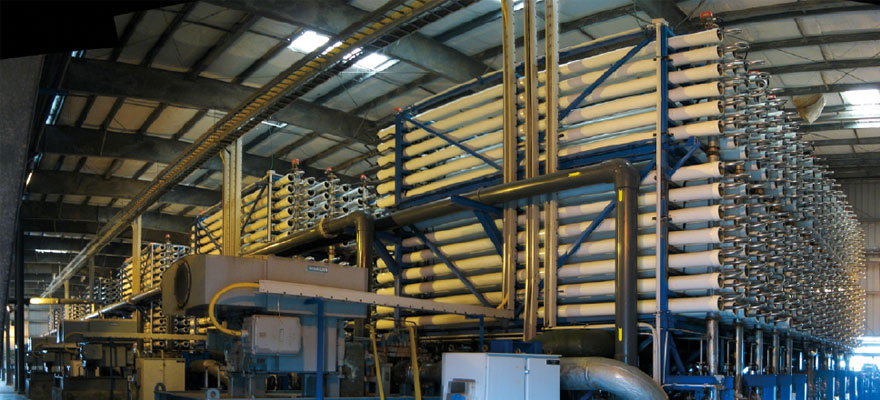Home > Highlighting JAPAN >Highlighting Japan December 2013>Japan's technological achievements
Highlighting JAPAN
Science & Technology
The Mega-ton Water System
Seawater reverse osmosis may provide drinking water for the world

The United Nations estimates that the Earth's population will increase by over three billion by the year 2050 – an increase that is expected to place significant strain on existing freshwater supplies.
Seawater desalination may be used to meet these future human needs. To date, most large desalination plants have operated through multi-stage flash distillation (MSF), where seawater is distilled by boiling it and collecting the condensed steam. However, seawater reverse osmosis (SWRO) is capable of converting a greater percentage of the input seawater into freshwater, and may represent the next step in desalination technology.
"Japan has a lot of rainfall, so there is no domestic need for high-end water treatment plants," explains water research veteran Dr. Masaru Kurihara, whose work with Toray Industries, Inc. has seen him involved in water treatment research since the 1970s. "So from the outset, our water research was aimed at countries such as Saudi Arabia and China, which need reliable fresh water supplies for their businesses and agriculture."
Dr. Kurihara has witnessed first-hand Japan's rise in the international water research field. By the 1980s, Japan had 60-70% of the global share of MSF water treatment plants. But the emergence of the Republic of Korea as a manufacturer of MSF water treatment plants, with its lower exchange rate and cheaper production costs, ate away Japan's share in total
plant systems.
In SWRO, saltwater is forced through a membrane that allows only freshwater through, leaving the salt behind. Japan retains a strong hold of the SWRO membrane market – and it is the efficiency of the membrane that largely determines the viability of the SWRO process. In 2010, the Japanese government offered Dr. Kurihara ¥3.4 billion in funding to implement the Mega-ton Water System project, one of the 30 programs in the Funding Program for World-Leading Innovative R&D on Science and Technology (FIRST Program). The project sought to find methods of reducing the energy requirements and environmental impact of saltwater desalination through SWRO.
"To be more competitive, we need to create sustainable low-carbon desalination technologies that reduce the cost of operation. This will allow us to expand our client base to developing countries and urban coastal cities that need large-scale, low-cost desalination plants," explains Dr. Kurihara.
Current desalination plants are capable of producing just under half a million cubic meters of water a day (m3/d). Dr. Kurihara has been using the government funds to create the world's largest SWRO plant, capable of producing one million m3/d – a quantity roughly equal to one megaton in mass.
One important feature of the Mega-ton Water System is its use of low-pressure membranes. Thinner than conventional membranes, these low-pressure membranes have a wider surface area and narrower pores, requiring less pressure to desalinate seawater. According to Dr. Kurihara, lab samples have demonstrated a 20-30% reduction in energy consumption.
Another feature of the Mega-ton Water System is its use of pressure retarded osmosis (PRO) as an energy recovery device. PRO allows energy retrieval through the difference in salt concentration between saltwater and freshwater. Dr. Kurihara's team found that using PRO also reduced the salt content of the concentrated discharge, resulting in a smaller marine environmental impact.
The team also reduced waste output by integrating discharged brine water from its first stage SWRO plants into a second stage reverse osmosis, resulting in an increased input-to-output efficiency. The Mega-ton Water System enabled 65% of input seawater to be converted into drinking water, compared to conventional rates of 40-45%, while also resulting in a 20% reduction in energy consumption overall.
As the project now wraps up, Dr. Kurihara wants to do pilot tests on a smaller version of the system to confirm its low cost and low environmental impact. When the system is ready for commercial production, Japan will be able to offer a cheaper, more efficient water supply system to meet the needs of a growing world.
© 2009 Cabinet Office, Government of Japan






